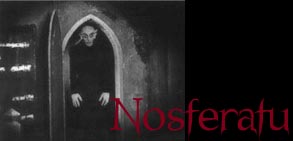






|
Bram Stoker wrote with ironclad 19th century Victorian values, inspiring no end of analysis from readers who wonder if the buried message of Dracula might be that unlicensed sex is dangerous to society.
The Victorians feared venereal disease the way we fear AIDS, and vampirism may be a metaphor; the predator vampire lives without a mate, stalking his victims or seducing them with promises of bliss--like a rapist, or a pickup artist. The cure for vampirism is obviously not a stake through the heart, but straight-laced familes and pure ideals. Next, we see Orlok advancing on Hutter while, in Bremen, his wife, Ellen, sleepwalks and cries out a warning that causes the vampire to turn away. (He advances and retreats through an archway shaped to frame his batlike head.) Later, after Hutter realizes his danger, he escapes from the castle and races back to Bremen by coach, while Orlok travels by sea, and Murnau intercuts the coach with shipboard events and Ellen restlessly waiting. The shots on the ship are the ones everyone remembers. The cargo is a stack of coffins, all filled with earth (from the nourishing graveyards of the plague). Crew members sicken and die. A brave mate goes below with a hatchet to open a coffin, and rats tumble out. Then Count Orlok rises straight up, stiff and eerie, from one of the coffins, in a shot that was as frightening and famous in its time as the rotating head in ``The Exorcist.'' The ship arrives in port with its crew dead, and the hatch opens by itself. -Roger Ebert "Chicago Sun Times"  The plot of Nosferatu Vampyres Only: The best Vampyre site on the net ....more to come The 1920s Goth | Gothy Works | Woes and Misfortunes The 1920s Gothic House | Gothic 1920s Theme Party  unless noted |